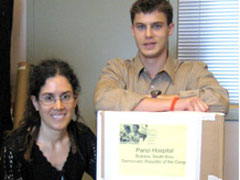Putting Thought Into Practice
By Jim Oldfield
“I was sickened and overwhelmed to the point of paralysis. That’s how it all started,” says Cathy Nangini. It was summer 2004, and she had read a Globe and Mail article by Stephanie Nolen on mass rape as a war tactic in the Democratic Republic of Congo. Over 40,000 women have been raped in the conflict since 1998, many so brutally they are left with a fistula — puncture of the bladder, vagina or rectum. Ostracization and death often follow.
Later that year, still horrified by what she had read, but no longer paralyzed into inaction, Nangini attended a World AIDS Day talk on Africa at the University of Toronto by Dr. James Orbinski, past president of Doctors Without Borders. For her it was a turning point, from which sprang a small and focused initiative — the Panzi hospital campaign — bringing aid to rape victims near the Democratic Republic of Congo’s eastern border with Rwanda.
And it grew.
Nangini and Brad MacIntosh, PhD students in the discipline of imaging at Sunnybrook Research Institute (SRI), established the campaign through a collaborative founded by Nangini, Student Aid for the Elimination of Rape (SAFER), in partnership with organizations including Rights and Democracy and the Canadian Embassy in Kinshasa. Identifying a key need of the resource-strapped Panzi hospital for treating fistula patients — specialized surgical wound care sutures — they gave donors a tangible way to help. Nangini says, “People like to know what they’re supporting is concrete. They understand a box of sutures, and the impact it can have.” Meanwhile, donors know they’re supporting international health and human rights. Says MacIntosh, “We have a small mandate, but a big picture in mind.”
In June 2006, SAFER shipped a one-year supply of sutures, worth $3,000 CAD, to the Panzi hospital. Another $3,000 has already been raised for a second shipment, in part due to a disc distribution effort in southern Ontario ultimate Frisbee leagues that is now spreading through Germany. It was one of several ideas interested donors brought to the campaign, and one of the few Nangini and MacIntosh had time to implement. Of the burgeoning campaign, MacIntosh smiles and says, “We need to graduate.”
Sunnybrook was instrumental in helping the initiative evolve. Staff at SRI gave generously, and Dr. Peter Burns, senior scientist in imaging, connected Nangini and MacIntosh with Les Boehm, director of research operations and business development, who led them to biomedical engineer Keith Laycock. Laycock runs a program to collect extra pieces of equipment and send it to countries in need and is collecting sutures, pulse oximeters, bed sheets and other items for the Panzi hospital. Boehm also introduced them to Tony Easty at the University Health Network (UHN), and SAFER is now working to establish a database wish list of items needed by the Panzi hospital to which UHN could contribute. This list would compliment SAFER’s ongoing efforts to document patient demographics in the DRC and the effects of violence on health resources.
Bringing federal clout, in March 2006 the Canadian International Development Agency announced $15 million that will help address sexual violence in the Democratic Republic of Congo. Nangini and MacIntosh lobbied the agency with a presentation in the House of Commons the previous year, and though neither accepts kudos for the new funding, their effort likely didn’t hurt. Boehm says, “I applaud Cathy and Brad for taking the time; they deserve a lot of credit. They’re just so enthused, and they motivate others to get involved. It’s beautiful to see.”
Donate to the Panzi hospital campaign at www.medicalreform.ca/congo
PDF / View full media release »


